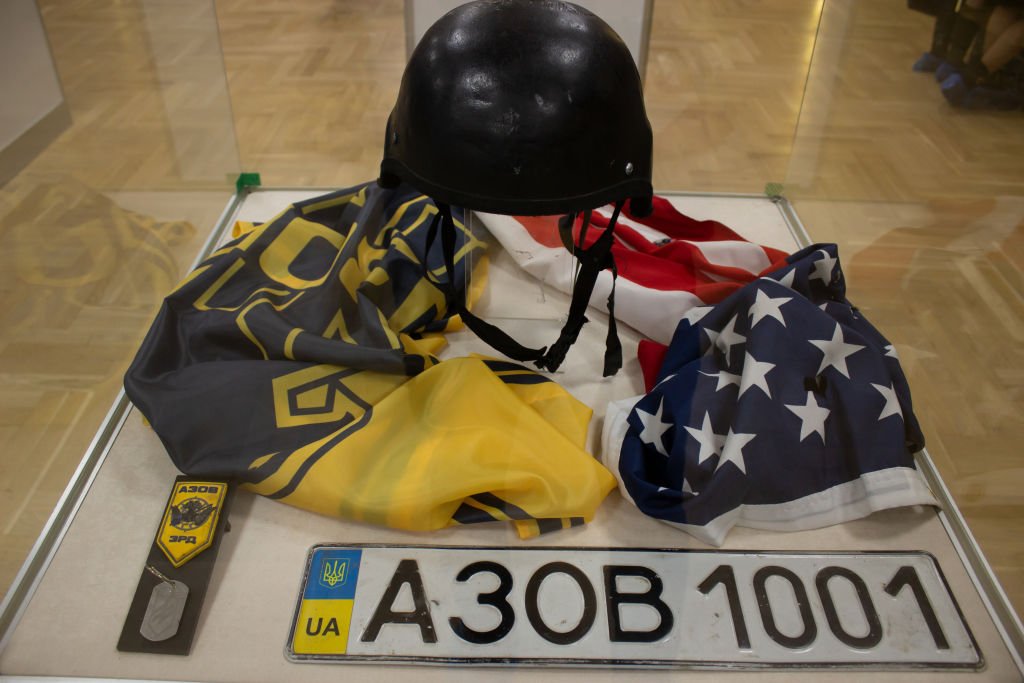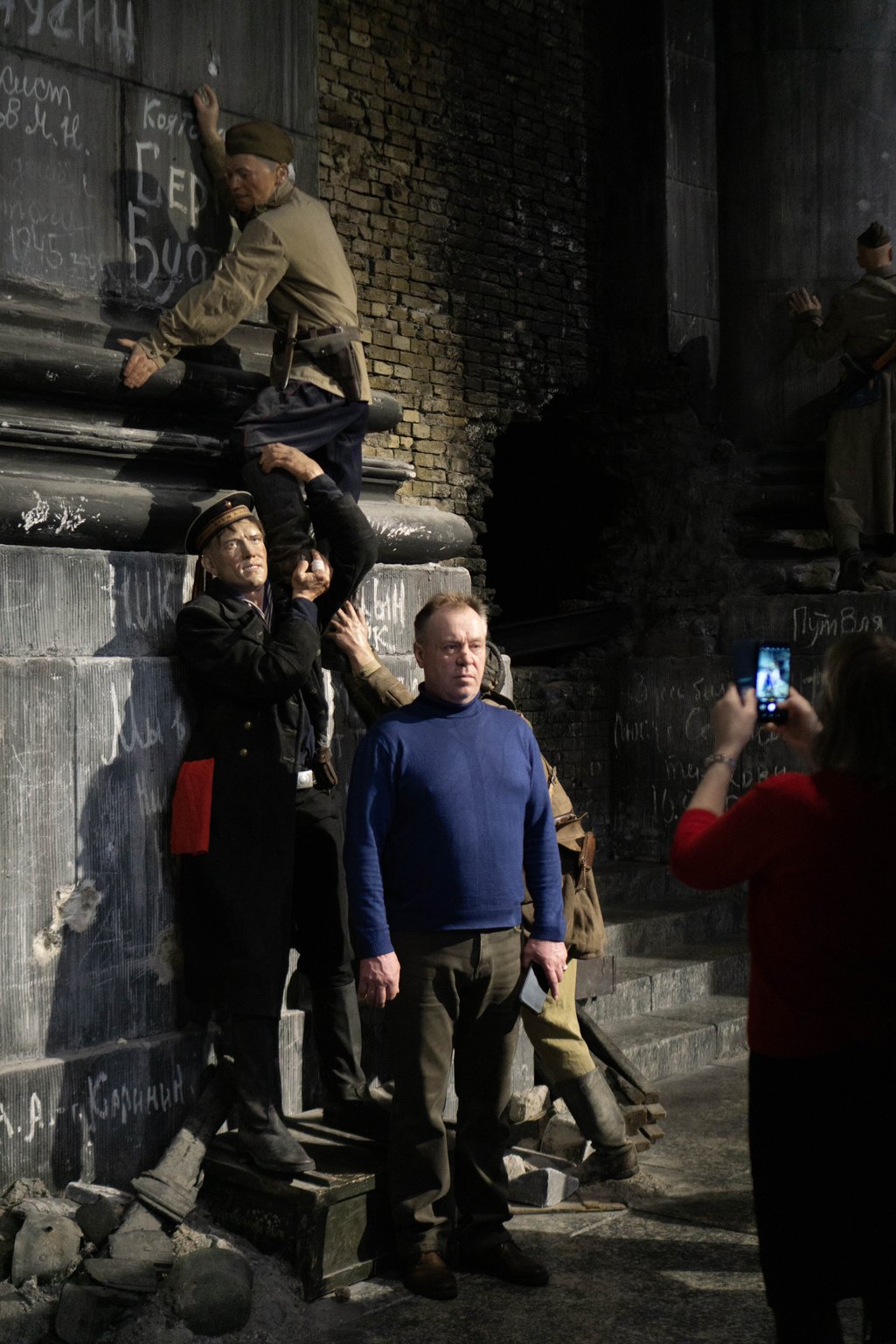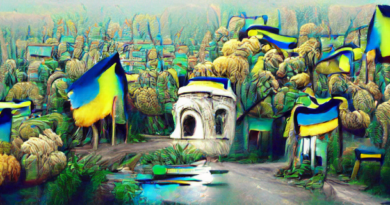Moscow museum equates Ukraine invasion with Second World War – openDemocracy
The view from the half-ruined farmhouse is terrifying. A sobbing girl is being dragged off by a German soldier as Wehrmacht troops advance through her village. The air is filled with the sound of gunfire and angry voices. One can almost smell the fire and blood. As our group walks away from the mayhem, we are stopped by a young partisan brandishing a rifle, who demands we identify ourselves.
But none of this is real. The farmhouse is a replica, the impending rape is being portrayed by wax figures, and the noisy German advance is a film, projected behind the life-size set to create an immersive 3D-experience. The young partisan is an actor, his rifle a prop, and the woman producing the papers he is demanding is our tour guide.
This isn’t the Soviet countryside in the autumn of 1941, but the Victory Museum in Moscow on a grey winter’s day a year or so after Vladimir Putin’s full-scale invasion of Ukraine. However, the difference between the war being re-enacted here in Russia’s largest museum of military history and the one currently raging a few hundred kilometres to the south is increasingly blurry.
History plays a key role in the official Russian discourse surrounding the invasion of Ukraine. In particular, the Second World War – or the Great Patriotic War, as it’s known from the Soviet perspective – and its supposed parallels with Russia’s current war has become a major trope in the state’s efforts to legitimise Putin’s foreign policy and compel the population to endure the hardships it entails.
The Kremlin drew similar parallels back in 2014, during Russia’s initial intervention in Ukraine. In fact, mythologising the victory over Hitler has been a cornerstone of the Putinist project since the early 2000s. While Putin was cementing Russia’s neoliberal kleptocracy, steadily rolling back the democratic advances of perestroika and the 1990s, that victory cult took on ever greater proportions.
It was embodied by ever larger and more spectacular commemorative military parades, featuring reenactments by extras in WW2 uniforms and vehicles. In a disorientating era of post-history, such performative patriotism became a way of linking the generations, experiencing historical connectedness and finding unity.
But history has returned, and the management of memory has taken on a new relevance. This shift is plainly visible at the Victory Museum, where new exhibitions have appeared since the invasion. The result is an extravagantly kitschy potpourri of pomp, nostalgic in content, yet futuristic in form. Its leitmotif, expressed both subtly and overtly, is that past and present are one.
The immersive diorama of a war-ravished countryside, for instance, is part of ‘Feat of the Nation’. Although the exhibition, like the museum as a whole, is supposed to be about the Great Patriotic War, it seems it is also, perhaps even primarily, about the war in Ukraine. Our enthusiastic young tour guide switches seamlessly between third- and first-person plural, between past and present tense, as she leads us from the initial German assault via the blockade of Leningrad all the way to Berlin.
“Step closer, comrades, but please be quiet to avoid disturbing the cabinet meeting,” says an actor, dressed as one of Stalin’s clerks. We are allowed to peek into a dark conference room. Inside, holograms of the Soviet leader and his war cabinet are discussing the situation at the front.
Moments before, our tour guide had told us not to believe the “stupid stories” claiming that Stalin, stunned by the scale of the unfolding disaster, had been unable to act decisively during the first weeks of the invasion. At subsequent stops, she peppers us with facts and figures illustrating the nearly supernatural power of “our people”, when called upon to defend “our country”.

Trophies captured by the Russian military in Ukraine in 2022 on display at the State Central Museum of Contemporary History of Russia in Moscow. They include a vehicle registration plate showing the name ‘Azov’
|
Vlad Karkov / SOPA Images / LightRocket via Getty Images
Towards the end of the tour, just before we take selfies in front of the Reichstag, our guide speaks warmly of the Soviet army’s humane treatment of civilians under occupation: “We don’t destroy. There are no executions or torture. Our Soviet army helps. And by the way, what is happening now, in our time, is a telling example of how this legacy of our soldiers is being continued.”
For those curious to learn more about what it is, exactly, that is happening in our time, she recommends other exhibitions at the museum. They also suspend the difference between then and now, but by depicting current events as if they were part of the past.
‘Ordinary Nazism’ portrays the “Ukrainian variant of Nazism”. One wall illustrates the crimes of German-allied Ukrainian nationalists in WW2; the opposite wall describes today’s Ukrainian military as their direct heirs.
There are some familiar but dubious factoids – for example, that Ukrainian forces killed 20,000 civilians in the first eight years of the Donbas war (the UN estimates a total of 15,000 deaths, civilian and military, from both sides.) Emotional pressure triumphs over factual accuracy. To the sound of an eerily ticking metronome, two screens juxtapose footage of Hitler’s soldiers committing atrocities on the eastern front with protesters on Kyiv’s Maidan Square in 2014.
Another exhibition, ‘Ordinary NATOzism’, seeks to show how the Western military alliance is also part of the same anti-Russian conspiracy, with roots going back to the 1940s. Its agenda is world domination and its tools include laboratories developing biological weapons in Ukraine. Luckily, says the film narrator, the “special military operation” launched by Putin put a stop to NATO’s sinister plans.
What these exhibitions illustrate is a qualitative shift in Russian memory politics. The performative patriotism that blossomed before 2014 may have been an evocative rallying cry, but it lacked any clear cause – like a marching order without directions. In a Russia at war, with military mobilisation in effect, such a context now exists.
This context is made as plain as can be on the top floor, in an exhibition with a title that might best be translated as ‘True to Their Legacy’, which invites visitors to partake in the same heroic struggle, against the same enemy, here and now.
In it, the Russian troops currently fighting in Ukraine are depicted as carrying on the fight of those who defeated Hitler. On interactive screens, visitors can swipe through hundreds of pairs of faces: one marked with the letters VOV (the Russian abbreviation for Great Patriotic War), the other with SVO (Special Military Operation). Visitors are given pens and paper and encouraged to write letters of support to the troops at the front.

Interactive exhibit at the Victory Museum
|
Volodya Vagner
In the context of the Ukraine invasion and its implied continuity with the Great Patriotic War, all the mythology surrounding the latter takes on a contemporary imperative: to re-enact – in actuality – the same feats of sacrifice and endurance.
The spirit being channelled is that of the popular patriotic slogan Mozhem povtorit (“We can do it again”). The message is to trust the leader, who knows what he is doing, despite all appearances, and to accept the sacrifices that eventually will bring victory, despite all odds.
The question is to what degree the audience internalises this message. To a population used to participating in state-orchestrated mimicry, from rigged elections to mass rallies organised from above, why should the martial zeal drummed up here be perceived to function differently?
Despite the high-tech immersion, much of the visitors’ engagement remains superficial. Take one of the interactive video installations. As visitors stand in front of a green screen and watch Donbas civilians tearfully embrace Russian soldiers to the sound of patriotic music, they are virtually transposed into the thick of the war. Afterwards, they are encouraged to scan a QR-code and download the movie they co-starred in as a souvenir.
Rather than conveying profundity, much of this patriotic pomp thus ends up as gimmicky infotainment, a product to be consumed, like the toy tanks and Z-trinkets for sale in the museum gift shop.
Just as rigged elections can only simulate popular support for the regime, it may turn out that virtually reenacting a heroic past may not be worth much in preparing the population for actual hardships to come.
This article has been archived for your research. The original version from Open Democracy can be found here.


